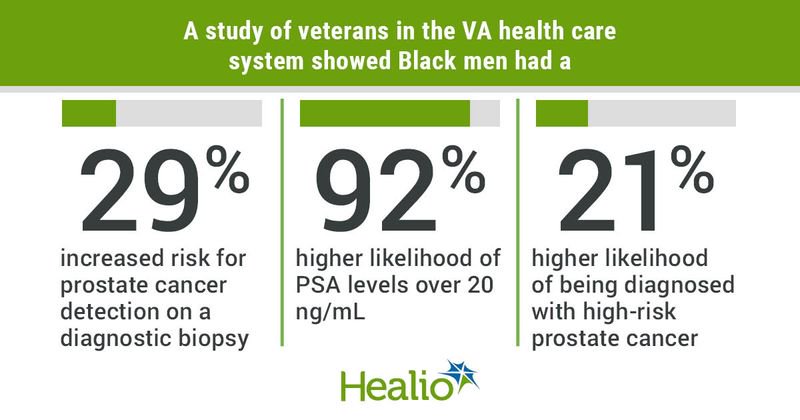Racial disparities observed in prostate cancer incidence, outcomes among veterans
Black veterans had a nearly twofold higher incidence of both localized prostate cancer and de novo metastatic disease compared with white veterans, according to a nationwide, retrospective cohort study published in JAMA Network Open.
“This study showed that in a nearly equal access-to-care setting, increased incidence of prostate cancer is an important driver of the increased residual disparity in prostate cancer metastasis among Black men,” Kosj Yamoah, MD, PhD, chief of genitourinary radiation oncology and director of radiation oncology cancer health disparities research at Moffitt Cancer Center, told Healio. “Furthermore, appropriate and timely delivery of therapy can reduce the risk for adverse events, including metastasis and death due to prostate cancer in Black men.”

Background
Yamoah and colleagues conducted the study because, although prostate cancer disproportionally affects Black men, limited research evaluating racial and ethnic disparities in equal-access settings existed.

“Emerging studies have shown comparable treatment outcomes across racial groups when such outcomes are evaluated within equal-access settings, such as clinical trials,” Yamoah said. “Results of these studies have invigorated the debate on whether equal access to care can completely eliminate these disparities, with the assumption that the observed disparities are solely a function of disparate socioeconomic status.”
Thus, with the Veterans Affairs database, Yamoah said researchers had a “unique environment” to investigate prostate cancer health disparities because the VA provides care in an equal-access system compared with larger health care systems.
Methodology
The analysis included 92,269 veterans (69% white, 31% Black) diagnosed with localized prostate cancer while undergoing routine care at VA hospitals nationwide from 2005 through 2019.
Yamoah and colleagues estimated age-adjusted incidence of localized and de novo metastatic prostate cancer, evaluated treatment response and compared prostate cancer-specific outcomes between Black and white veterans. Additionally, researchers estimated the residual disparity in prostate cancer outcome, which they defined as the leftover racial and ethnic disparity in outcomes despite equal treatment.
Time to distant metastasis following prostate cancer diagnosis served as the primary outcome.
Key findings
In addition to being younger than their white counterparts (median age, 63 years vs. 65 years), Black veterans tended to have higher PSA levels (> 20 ng/mL) at the time of diagnosis. They also had a nearly twofold greater incidence of both localized and de novo metastatic prostate cancer than white men, consistent with U.S. population-level data.
Additionally, compared with white men, Black men had a:
- 29% increased risk for prostate cancer detection on a diagnostic prostate biopsy (HR = 1.29; 95% CI, 1.27-1.31);
- 4% higher likelihood of high-grade Gleason scores ( 4 + 3; adjusted OR = 1.04; 95% CI, 1-1.07);
- 92% higher likelihood of PSA levels over 20 ng/mL (adjusted OR [aOR] = 1.92; 95% CI, 1.82-2.02); and
- 21% higher likelihood of being diagnosed with high-risk prostate cancer (aOR = 1.21; 95% CI, 1.16-1.25).
Although researchers reported Black men receiving definitive primary treatment of prostate cancer had a lower risk for metastases (adjusted HR [aHR] = 0.89; 95% CI, 0.83-0.95), Black men classified as “other” race and who received treatment appeared more likely to develop metastasis (aHR = 1.29; 95% CI, 1.17-1.42), Yamoah and colleagues wrote.
Yamoah said he found it surprising that Black men treated with primary definitive radiotherapy had better metastasis-free survival outcomes.
“However, outcomes were identical among men who chose surgery as primary therapy,” he added. “It is important to caution that these data do not suggest one treatment modality is better than the other, since this study does not perform a direct comparison between surgery or definitive radiotherapy.”
Implications
Yamoah told Healio that future research should focus on identifying the factors that result in increased incidence of prostate cancer among Black men and developing strategies to improve access to care for this population.
“Pursuing both goals simultaneously will provide the best chance at effectively addressing the problem of prostate cancer health disparities,” Yamoah said.
For more information:
Kosj Yamoah, MD, PhD, can be reached at Moffitt Cancer Center, 12902 USF Magnolia Drive, Tampa, FL 33612; email: kosj.yamoah@moffitt.org.

